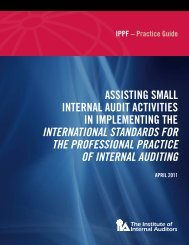2011 State of the Internal Audit Profession Study - PwC
2011 State of the Internal Audit Profession Study - PwC
2011 State of the Internal Audit Profession Study - PwC
Create successful ePaper yourself
Turn your PDF publications into a flip-book with our unique Google optimized e-Paper software.
Meanwhile, despite a slowly recovering<br />
world economy, debt continues to rise,<br />
prompting countries to look to <strong>the</strong>ir<br />
tax structures for relief. To cope with<br />
tax, financial reform, and regulatory<br />
change, leading audit functions are:<br />
• Performing global regulatory<br />
compliance risk assessments<br />
• Taking an active role in assessing<br />
and developing corporate compliance<br />
programs with a focus balanced<br />
between compliance assurance and<br />
recommendations to improve <strong>the</strong><br />
efficiency <strong>of</strong> processes and controls<br />
• Monitoring new regulatory reform<br />
developments and reporting<br />
frequently to management and <strong>the</strong><br />
audit committee on changes and<br />
how <strong>the</strong>y affect <strong>the</strong> business<br />
• Working with senior management<br />
and <strong>the</strong> company’s legal and compliance<br />
functions to understand, assess<br />
and in some cases challenge <strong>the</strong><br />
company’s responses to regulatory<br />
change<br />
• Monitoring proposed changes to tax<br />
laws that may provide incentives for<br />
investment and innovation<br />
• Evaluating <strong>the</strong> impact <strong>of</strong> tax and<br />
regulatory changes on <strong>the</strong> business<br />
and assessing whe<strong>the</strong>r efficient and<br />
effective processes and controls are<br />
in place to support compliance<br />
Sustainability<br />
For participants in many industries,<br />
much <strong>of</strong> this recent regulatory movement<br />
has focused on a variety <strong>of</strong><br />
sustainability concerns. Although still<br />
an emerging area for many companies,<br />
<strong>the</strong> pace <strong>of</strong> regulatory developments<br />
and <strong>the</strong> breadth <strong>of</strong> social issues <strong>the</strong>y<br />
are intended to address show no sign<br />
<strong>of</strong> subsiding. Regulatory changes may<br />
have a pr<strong>of</strong>ound effect on <strong>the</strong> environment,<br />
employee health, and workplace<br />
safety. As a result, companies are<br />
developing more robust processes to<br />
comply with <strong>the</strong>se regulations and<br />
many are proactively using <strong>the</strong> sustainability<br />
movement to achieve a competitive<br />
advantage. Corporate social<br />
responsibility reports are becoming<br />
commonplace, and sales and marketing<br />
groups are making social responsibility<br />
statements in advertising and promotion<br />
materials. Companies should look<br />
closely at <strong>the</strong>ir ability to collect and<br />
report data to both regulatory agencies<br />
and <strong>the</strong> public to ensure that <strong>the</strong>se<br />
assertions are supportable.<br />
<strong>Internal</strong> audit should play an important<br />
assurance role in <strong>the</strong> design,<br />
implementation, and monitoring <strong>of</strong><br />
<strong>the</strong>se processes and controls.<br />
Our <strong>State</strong> <strong>of</strong> <strong>the</strong> <strong>Internal</strong> <strong>Audit</strong><br />
Pr<strong>of</strong>ession <strong>Study</strong> indicates that corporate<br />
social responsibility and sustainability<br />
are growing areas <strong>of</strong> internal<br />
audit interest, with 35% <strong>of</strong> survey<br />
respondents indicating that <strong>the</strong>ir audit<br />
plans explicitly address <strong>the</strong>se issues.<br />
Our discussions with leading CAEs<br />
also indicated increasing focus in<br />
<strong>the</strong>se areas. While audit approaches<br />
are continuing to evolve, leading<br />
internal audit functions are actively<br />
engaging <strong>the</strong> business to better<br />
understand <strong>the</strong> risks and exposures.<br />
Approaches include:<br />
• Compiling an inventory <strong>of</strong> regulatory<br />
reports and public statements<br />
and assessing <strong>the</strong> potential<br />
brand risks<br />
• Performing data mapping exercises<br />
and assessing <strong>the</strong> processes and<br />
controls to ensure accuracy <strong>of</strong> data<br />
• Assisting in <strong>the</strong> development <strong>of</strong> policies<br />
and procedures for review and<br />
approval <strong>of</strong> public statements about<br />
social responsibility<br />
• Assisting in <strong>the</strong> development <strong>of</strong><br />
regulatory compliance programs<br />
14 Lights, camera, action… Scripting internal audit for a changed world


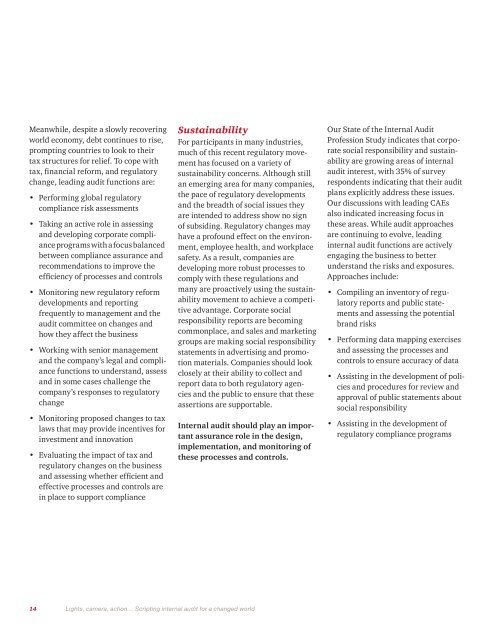
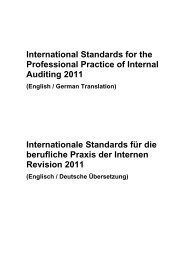

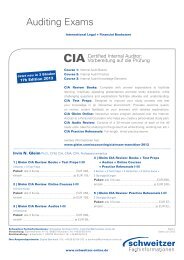
![Ausgabe 02_2011 [PDF, 3.4 MB] - Institut für Interne Revision ...](https://img.yumpu.com/37945857/1/184x260/ausgabe-02-2011-pdf-34-mb-institut-fa-1-4-r-interne-revision-.jpg?quality=85)
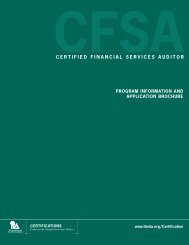
![Ausgabe 2004.2 [PDF, 1.1 MB] - Institut für Interne Revision Ãsterreich](https://img.yumpu.com/37941871/1/184x260/ausgabe-20042-pdf-11-mb-institut-fa-1-4-r-interne-revision-asterreich.jpg?quality=85)
![Ausgabe 02_2009 [PDF, 1.2 MB] - Institut für Interne Revision ...](https://img.yumpu.com/37941824/1/184x260/ausgabe-02-2009-pdf-12-mb-institut-fa-1-4-r-interne-revision-.jpg?quality=85)
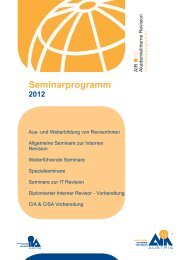
![Ausgabe 03_2011 [PDF, 9.1 MB] - Institut für Interne Revision ...](https://img.yumpu.com/37941423/1/184x260/ausgabe-03-2011-pdf-91-mb-institut-fa-1-4-r-interne-revision-.jpg?quality=85)
![Ausgabe 2006.2 [PDF, 852.7 KB] - Institut für Interne Revision ...](https://img.yumpu.com/37941416/1/184x260/ausgabe-20062-pdf-8527-kb-institut-fa-1-4-r-interne-revision-.jpg?quality=85)
![Ausgabe 03_2007 [PDF, 1.5 MB] - Institut für Interne Revision ...](https://img.yumpu.com/37941405/1/184x260/ausgabe-03-2007-pdf-15-mb-institut-fa-1-4-r-interne-revision-.jpg?quality=85)
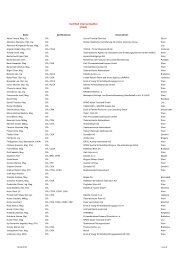
![CEE Konferenzprogramm [PDF, 11.8 MB] - Institut für Interne ...](https://img.yumpu.com/37941387/1/184x260/cee-konferenzprogramm-pdf-118-mb-institut-fa-1-4-r-interne-.jpg?quality=85)
